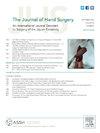The Effect of Forearm Shortening on Finger Flexion: A Biomechanical Study
IF 2.1
2区 医学
Q2 ORTHOPEDICS
引用次数: 0
Abstract
Purpose
Surgeons may shorten the forearm for many indications. We quantified the impact of shortening on finger flexion with a cadaver model.
Methods
Ten fresh cadaver proximal forearms were pinned to a static block. We pinned each distal forearm/hand to a block that could unlock, slide, and relock on a mounting track. This block allowed wrist-neutral or 30-degree extension. With the sliding block locked, we removed the central 10 cm of the radius/ulna. We placed sutures in the proximal end of each flexor digitorum profundus (FDP). After pretensioning, we simulated near-maximum baseline FDP muscle-generating force by applying 100 N via a load cell at the proximal sutures. We then anchored the load cell system proximally to set the initial length-tension relationship for simulating near-maximum baseline muscle-generating force. We called subsequent load cell readings the simulated muscle force (SMF) and pressure sensor readings between fingertips and the palm the tip-to-palm force (TPF). We shortened the forearm in 1 cm increments with the distal sliding-locking block. At each increment, we recorded SMF and TPF in the wrist-neutral position. Once a specimen lost measurable TPF, we applied 30 degrees wrist extension until again losing TPF.
Results
Incremental forearm shortening was associated with exponential decreases in each FDP’s SMF and TPF. In wrist-neutral, 3 cm mean shortening had a loss of 99% and 98% SMF and TPF, respectively. Wrist extension marginally improved SMF and TPF up to 4 cm mean shortening, where both lost 99%. Loss of any fingertip touchdown occurred after a mean shortening of 4.9 cm in wrist-neutral and 5.3 cm in 30 degrees wrist extension.
Conclusions
Mean forearm shortening of 3 or 4 cm had a near-complete loss of FDP SMF and TPF in wrist-neutral/wrist extension, respectively. With ∼5 cm shortening, there was a complete loss of fingertip touchdown.
Clinical relevance
Surgeons should consider the influence of forearm shortening on the FDPs and contemplate flexor tendon shortening or alternative reconstructions as indicated.
前臂缩短对手指屈伸的影响:生物力学研究
目的:外科医生可能会因多种适应症而缩短前臂。我们用尸体模型量化了缩短对手指屈曲的影响:方法:将十个新鲜的尸体前臂近端固定在一个静态块上。我们将每个前臂/手的远端固定在一个可在安装轨道上解锁、滑动和重新锁定的块上。滑动块允许腕关节保持中立或伸展 30 度。锁定滑动块后,我们切除了桡骨/股骨中部 10 厘米的部分。我们在每个屈指肌(FDP)的近端进行了缝合。预拉伸后,我们通过近端缝合处的称重传感器施加 100 牛顿的力,模拟接近最大基线的 FDP 肌肉发力。然后,我们将称重传感器系统固定在近端,为模拟近最大基线肌力设定初始长度-张力关系。我们将随后的称重传感器读数称为模拟肌力(SMF),将指尖和手掌之间的压力传感器读数称为指尖到手掌的肌力(TPF)。我们用远端滑动锁定块以 1 厘米的增量缩短前臂。每次增量时,我们都记录手腕中立位置的 SMF 和 TPF。一旦标本失去了可测量的 TPF,我们就将其手腕伸展 30 度,直到再次失去 TPF:结果:前臂缩短的递增与每个 FDP 的 SMF 和 TPF 的指数下降有关。在腕关节中立位时,3 厘米的平均缩短分别导致 99% 和 98% 的 SMF 和 TPF 损失。腕关节伸展可略微改善SMF和TPF,但平均缩短4厘米时,SMF和TPF的损失率均为99%。在腕关节中立状态下平均缩短 4.9 厘米和腕关节伸展 30 度时平均缩短 5.3 厘米后,指尖触地率均有所下降:结论:前臂平均缩短 3 或 4 厘米时,腕关节中立位/腕关节伸展时的 FDP SMF 和 TPF 分别接近完全丧失。当缩短幅度达到 5 厘米时,指尖触地功能完全丧失:外科医生应考虑前臂缩短对 FDP 的影响,并根据情况考虑屈肌腱缩短或其他重建方法。
本文章由计算机程序翻译,如有差异,请以英文原文为准。
求助全文
约1分钟内获得全文
求助全文
来源期刊
CiteScore
3.20
自引率
10.50%
发文量
402
审稿时长
12 weeks
期刊介绍:
The Journal of Hand Surgery publishes original, peer-reviewed articles related to the pathophysiology, diagnosis, and treatment of diseases and conditions of the upper extremity; these include both clinical and basic science studies, along with case reports. Special features include Review Articles (including Current Concepts and The Hand Surgery Landscape), Reviews of Books and Media, and Letters to the Editor.

 求助内容:
求助内容: 应助结果提醒方式:
应助结果提醒方式:


